When people hear “sales,” they probably think cold emails or talking with some sleezy sales rep just trying to close the deal and hit a quota.

But the world of sales and eCommerce is changing fast as more and more folks do shopping online. People are increasingly ordering necessaries on Amazon instead of going to their local department store chain. Ordering grocery delivery instead of going to grocery stores is quickly becoming a norm. Even big purchases like cars and houses are moving online.
Our business sells a digital subscription so it only made sense to do all or our sales activity online, too. In the digital space, the HubSpot sales CRM has helped us:
- Make our entire sales process more efficient
- Scale our sales team from 1 to 3 people
- Focus on inbound sales instead of disruptive sales tactics
That’s why I thought it would be helpful to go through exactly how WP Buffs used HubSpot to close almost $50K of recurring revenue so far in 2020 (Jan 1 - Aug 4).
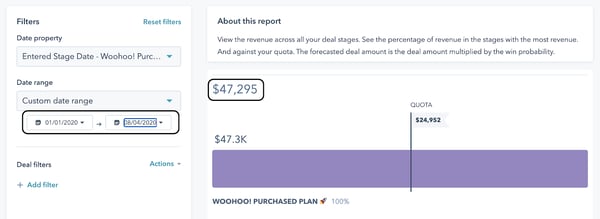
A Bit More About WP Buffs
Before I dive into our sales process, let me tell you a bit more about WP Buffs.
WP Buffs provides 24/7 WordPress support services to power digital growth. That means maintenance services for serious website owners and white-label site management for agencies and freelancers.
Our team of 25+ works 100% remotely from every corner of the planet. We’re a diverse team solving diverse WordPress challenges.
→ Access Now: 50 Customer Service Email Templates [Free Resource]
We also love to help make WordPress easier for folks, even if it's for free. The annual WPMRR Virtual Summit and the WPMRR WordPress podcast are just a couple ways we give back to the community.
Attracting and Capturing Leads
Before we can even start the sales process, we need to get some leads in the top of our funnel.
Our main customer acquisition channel is content. We drive traffic to our website through our blog and YouTube channel. Currently, we’re starting to focus more on our affiliate program. Google Ads and sponsorships as lead generation channels but those are less effective right now than the SEO work we do.
Once people land on our website, we capture leads in three main ways:
1. They book a call.
This is the best kind of lead because it’s somebody who’s clearly interested in learning more about our subscriptions — a hot lead.
The HubSpot CRM has a great meetings tool for this (more later) that allows anyone to easily book a call with sales folks on our team. We easily embed this right on our website and it works like a charm.

2. They livechat with us.
We use the HubSpot livechat software, part of their CRM, to chat with folks reading about our services right on our website.
From there, we collect an email address to follow up with them about booking a discovery call (see above).

3. We collect their email address
Some people want to receive our community newsletter. Others want to read our free eBooks and case studies. Either way, those potential leads sign up for our email list.

Once they’re confirmed in ConvertKit, we send them lots of free tutorials, videos, etc. to help make WordPress easy for them. And at some point of their email journey with us, they may click a link that will tag them as a potential customer or agency partner.

We then use Zapier to collect their name, email address, and tag from ConvertKit and pull that into HubSpot as a new sales lead.
Using HubSpot Sequences
HubSpot email automation sequences are at the core of how we send personalized sales emails while scaling our effectiveness at the same time.
Let’s say somebody livechats with us and leaves their email address but doesn’t book a call. We’ll follow up with a sequence of emails to try to get them to schedule a time to talk.
HubSpot email sequences are great because:
- They automatically pull in personal contact details via token. That means I can add somebody to a sequence and automatically include their first name in the subject line, their website URL in the body of the email, etc. This makes it much faster/easier to send highly personalized emails that get more opens, clicks, and booked calls.
- People who respond to an email or book a call are automatically removed from sequences to spare their inboxes.
- We’re big on respecting people’s space and HubSpot allows us to include email opt out links at the bottom of every email — people can unsubscribe anytime.

If somebody doesn’t reply or book a call, they’re sent a second follow-up. Then a third. If they still haven’t taken action at that point, we decrease our email outreach. Someone on our team is automatically assigned the task to add them to our monthly/quarterly follow-up sequence.

HubSpot also gives great data on how our email sequences are performing. Knowing the rate at which people book meetings from this particular sequence allows me to make changes, see what the new meeting rate is, and know if my email copy was better or worse after my amendments.

Effectively Booking Sales Calls
Making this process really easy for people is super important for conversion rate. Luckily, HubSpot makes this simple with its meeting scheduler.
We can set up Round Robin to show the availability of our sales team to make booking calls easier for visitors. Because we’re all in different time zones, this makes it easy for leads to find someone on our team available when they are.

HubSpot also has a direct integration with Zoom. Whenever someone books with a sales rep, that sales rep’s Zoom room link is automatically added to the calendar invite and sent to the person who booked the meeting.
That calendar invite is also added to the sales team calendar. When it’s time for the call, we get a reminder and will have all of the potential customer’s details right in the calendar invite.
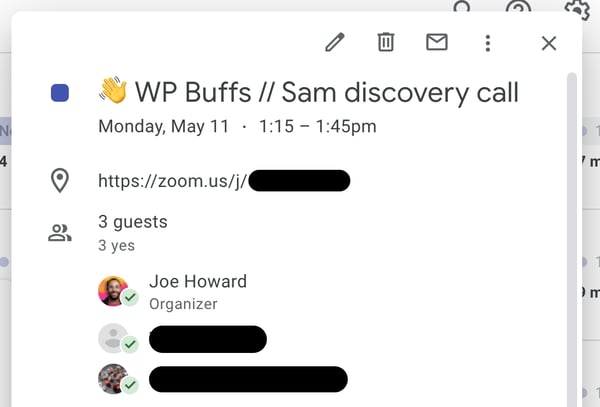
Plus, HubSpot can send out reminder emails before meetings as a quick reminder. We send out emails both 24 hours and 10 minutes before calls.

Before somebody is able to book a call, we have them answer a few questions. We could probably ask fewer questions and book more calls, but our focus is to attract high-quality leads. If people don’t want to answer, they’re probably not the right candidate for us.
Plus, getting answers to these questions really improves the conversion of calls to new customers. When we know their biggest challenge with WordPress, we know the pain point we need to address that will entice them to sign up for WP Buffs site management subscriptions.
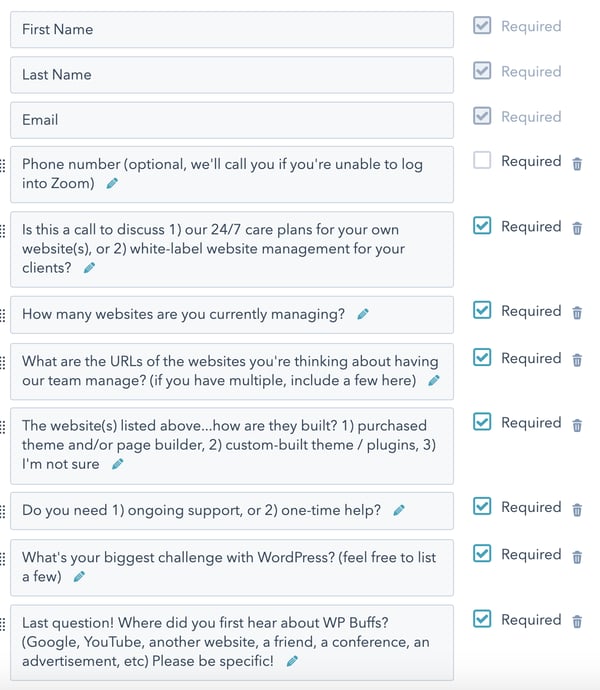
After the Discovery Call
Once their discovery call is complete, guess what? They go into another HubSpot email sequence.
Technically, this sequence sends templated emails, but we have clear instructions to personalize the follow-up email as much as possible.

If they don’t end up converting, they go into another monthly/quarterly follow up sequence. Ideally, they’ll decide to sign up for a care plan or to join our white-label program.
And if they do, we again use Zapier. When somebody signs up via WooCommerce, we’re alerted in Slack that a new customer or partner has signed up. Zapier also automatically adds them back into ConvertKit to start receiving onboarding emails.
And we have another Zap that automatically creates a new deal in HubSpot based on the new WooCommerce order details.
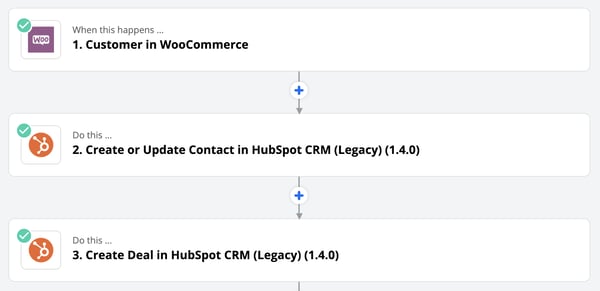
Then, the deal is automatically added into HubSpot.

In HubSpot, we can track how many new deals and recurring revenue we’re adding each month when we do periodic reviews.
Reporting
One of the best parts about HubSpot is the robust reporting.
It takes a bit of practice to get data from graphs and reports and to set up your contact details correctly, but once you do, you can see data that’s super actionable.
For example, here I can see new deals created based on lead source. This shows me the most effective high-quality lead generation channels for my business.
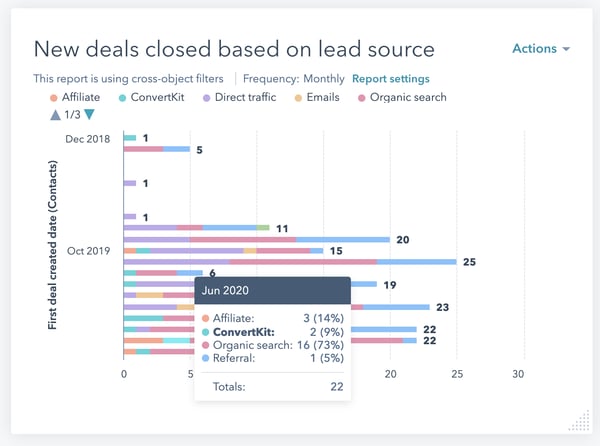
Wrapping Up
That’s how we use the HubSpot CRM at WP Buffs to make sales easy, effective, and scalable for a small sales team. Take what we’ve done and apply it for your own use, but remember to adjust as you go to fit your business’ needs.
Most importantly, the HubSpot CRM is free to try — what do you have to lose?